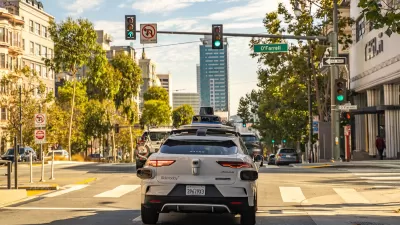Some Tesla autonomous modes direct the vehicle to engage in dangerous and illegal behaviors, prompting calls for increased regulation of autonomous vehicle tech.

According to an article by Streetsblog's Kea Wilson, Tesla is equipping its vehicles with a feature that lets drivers choose "how aggressively the vehicle applies many of its automated safety features on U.S. roads," essentially allowing the car to break common traffic laws under its "assertive" driving mode.
The rollout went largely unnoticed by street safety advocates until a Jan. 9 article in The Verge, when journalist Emma Roth revealed that putting a Tesla in 'assertive' mode will effectively direct the car to tailgate other motorists, perform unsafe passing maneuvers, and roll through certain stops ('average' mode isn’t much safer). All those behaviors are illegal in most U.S. states, and experts say there’s no reason why Tesla shouldn’t be required to program its vehicles to follow the local rules of the road, even when drivers travel between jurisdictions with varying safety standards.
The revelation concerns road safety advocates who say the company is endangering riders and pedestrians by allowing the cars to roll through stops and red lights. Wilson attributes this in large part to the fact that "by and large, U.S. law tends to favor penalizing individual drivers for breaking the law, rather than penalizing car manufacturers whose vehicle designs make breaking those laws easy," pointing to the lack of regulations for vehicles that can travel at speeds far beyond any legal speed limits.
Meanwhile, a complicated regulatory landscape puts autonomous vehicle technology in a challenging gray area, with some states attempting to pass laws that hold carmakers responsible for safety failures, while others are supporting more autonomous vehicle testing on their streets with statutes that shield manufacturers from liability.
FULL STORY: Why Tesla Can Program Its Cars to Break Road Safety Laws

Planetizen Federal Action Tracker
A weekly monitor of how Trump’s orders and actions are impacting planners and planning in America.

Chicago’s Ghost Rails
Just beneath the surface of the modern city lie the remnants of its expansive early 20th-century streetcar system.

San Antonio and Austin are Fusing Into one Massive Megaregion
The region spanning the two central Texas cities is growing fast, posing challenges for local infrastructure and water supplies.

Since Zion's Shuttles Went Electric “The Smog is Gone”
Visitors to Zion National Park can enjoy the canyon via the nation’s first fully electric park shuttle system.

Trump Distributing DOT Safety Funds at 1/10 Rate of Biden
Funds for Safe Streets and other transportation safety and equity programs are being held up by administrative reviews and conflicts with the Trump administration’s priorities.

German Cities Subsidize Taxis for Women Amid Wave of Violence
Free or low-cost taxi rides can help women navigate cities more safely, but critics say the programs don't address the root causes of violence against women.
Urban Design for Planners 1: Software Tools
This six-course series explores essential urban design concepts using open source software and equips planners with the tools they need to participate fully in the urban design process.
Planning for Universal Design
Learn the tools for implementing Universal Design in planning regulations.
planning NEXT
Appalachian Highlands Housing Partners
Mpact (founded as Rail~Volution)
City of Camden Redevelopment Agency
City of Astoria
City of Portland
City of Laramie





























